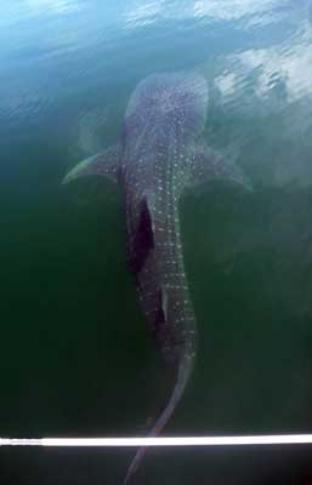Published in the Ocean Watch column, Honolulu Star-Advertiser © Susan Scott
November 22, 2010
 Last week I jumped in the water and swam with a 25-foot-long shark. We were so close I could have touched the shark’s side, and when it veered off, its enormous tail came within inches of sideswiping me. Clamoring back into my 8-foot-long rubber dinghy, I decided it might be best to watch the shark from there.
Last week I jumped in the water and swam with a 25-foot-long shark. We were so close I could have touched the shark’s side, and when it veered off, its enormous tail came within inches of sideswiping me. Clamoring back into my 8-foot-long rubber dinghy, I decided it might be best to watch the shark from there.
That sounds like a big-fish story, but it’s true. I was tagging along with the gentle giant of fish, a whale shark.
Whale sharks are the largest fish in the world. Reports abound of individuals 60 to 65 feet long, but the largest reliable report is 55 feet. The largest whale shark ever caught was in waters off Pakistan in 1949. That fish was 41 feet long.
After swimming next to my 25-foot-long whale shark, an estimate I made when it passed my 37-foot-long sailboat, I can see how guesses of this fish’s size get inflated. Even my so-called small one looked enormous when I was snorkeling next to it.
Besides the possibly of getting whacked by the tail when the fish turned, I was in no danger. Whale sharks have 300-some tiny teeth, but this species doesn’t need teeth to catch food.
Like manta rays, whale sharks are plankton eaters, sucking in nutrient-rich water in great gulps. Sieves in the gills filter out the goodies, and the water exits through five pairs of gill slits. The whale shark’s gill strainers trap seaweed, krill, larvae and fish as small as 1 millimeter, which is about as small as the human eye can see.
Although they can dive deeper than 3,000 feet, whale sharks usually feed at or near the surface, swimming forward with their mouths (up to 4 feet across) agape. Seeing those jaws wide open gave me pause, but these friendly fish have no interest in eating us and don’t mind being accompanied as long we’re respectful — no blocking or touching.
Whale sharks rove through the world’s tropical and subtropical waters either looking for plankton concentrations or returning to favorite places to give live birth. Wherever they go, their journeys are even slower than my sailboat, Honu, which averages 5 mph. The sharks’ cruising speed is about 3 mph.
Whale sharks come to Hawaii occasionally, but exactly when or where is up to the fish. I’ve heard of whale sharks spotted off the Waianae Coast, at Molokini, in Kona waters and at French Frigate Shoals. Whale sharks, however, can be anywhere (except the Mediterranean) the water is warm.
Some whale sharks travel to certain areas yearly during plankton blooms. The Sea of Cortez (Gulf of California) is one of those places.
When I sailed into whale shark sanctuary waters here, I didn’t know what to look for. As fish, whale sharks breathe water and blow no spouts.
But the sharks were easy to find on that flat, calm day. Their large back and tail fins cut the water’s surface in classic shark style. Seeing one heading in my direction, its head breaking the surface, I killed the little outboard on my dinghy and drifted. Please, please come close, I thought. And the shark granted my wish.
As it approached, the whale shark’s white spots against its blue-gray body vibrated in the bright morning sun, and the inside of its gaping mouth was brilliant white. That’s when I looped my camera around my neck, slipped into the water and had the thrill of a lifetime.
The picture here, though, I took from Honu’s bow.
In that one extraordinary morning, in the Sea of Cortez’s Bahia Los Angeles, I saw four of those polka-dotted giants. One was 70 feet long and swallowed my dinghy. Kidding. That’s a big-fish story.